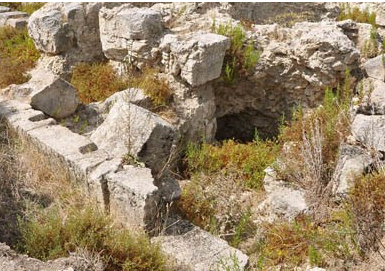ST – On its territory, the first world’s civilizations originated. Knowledge, culture and the first alphabet spread from it to all countries. From its inside, important archaeological monuments distributed to reflect the greatness of their locations and eras that rolled on its territory and the beauty of its landmarks and splendor. It is Lattakia, which remained fixed despite of the challenges of time and the elements of harsh nature.
In light of archaeological finds, during the past years, in Lattakia, the discovered cemeteries, that included graves of people who had the greatest impact on the emergence of these civilizations and building the monuments, have become the focus of attention of the world.
Director of the Antiquities Department at the governorate, Dr. Jamal Haider, pointed out that Lattakia owns an important archaeological storage of discoveries and every year more of them are discovered.
He referred that burying places were discovered in the ground, including an archaeological vault that was discovered in 1997, it is 250 meters to the south of the Mee’net Albeida. Its contents and model are consistent with the vaults discovered in Ugharit.
“According to data excavation, the great finds, which the vault contained dates to the thirteenth century BC, indicate that the number of those buried persons in it is about ten. According to archaeological data, it is believed that the vault was devoted to a family of a good social position. Discoveries found in the vault indicate that there were good relations and mutual influences with Egypt, Greece, Cyprus and Anatolia,” Dr.Haider clarified.
The vault is located two meters below ground level where it was built with dressed stone of eight building blocks, the lower line was built vertically and the higher one tend to inside toward the surface, which was covered by seven stone slabs which constitute the lock of the vault. The entrance to the vault from the south is accessible by two steps that lead to a narrow tiled vestibule leads to the door of the vault, and it is the access to the lobby of a rectangular tomb and there are five holes distributed to its walls and given numbers from 1 to 5.
After the excavation works, more than one hundred and fifty archaeological finds were discovered, including full parts, others were restored and others could not be restored. The finds were potteries, jars of various shapes and sizes, pitchers, plates, bowls, a doll in the shape of an ox and other in the shape of a dog, stone and calcareous finds, beads for decoration, calcareous vase, incomplete utensils, small fractions of a skeleton, decorated bones, bronze bowls and arrowheads used as weights for fishing nets, Dr. Haider added.
“Two carved coffins of sandstone were discovered in the neighborhood of al -Sheikh Dahir area at the center of Lattakia city. Motifs were carved into the facade and the sides of the first coffin while the back was left without decoration to the artist who would engrave the name of the person who would be buried inside the coffin,” Director of the Antiquities Department noted.
“The second coffin is the first of its kind in Syria in terms of size. Semi-circular wreaths in the shape of roses, beads, clusters of grapes, fruit, bay, pine and vine leaves were engraved on the coffin. Four embossed heads of bulls were separating among the wreaths and within these three wreaths there were three bust images of three girls and their faces were filled with grief and sorrow. The style of sculpture on these coffins was caring about pictorial decoration that prevailed in the reign of Antonyen Emperors during the second century AD,” Dr. Haider clarified.
According to Dr. Haider, a family vault was discovered in 1967. It is a large room dug in a block of sandstone which forms the geological basis of Lattakia city and despite the vandalism happened inside the vault traces of five holes engraved on the walls of the vault still exist. The holes were used for placing lamps, funerary offerings and vows.
Inside the vault, which dates back to the period of the Romanian era, there were landmarks of an incomplete church dug amid the lobby of the vault. The church is small and a nine- step stair dug in the rock leads to it. There is a temple in its northern wall and at the bottom of the eastern wall there are landmarks of a circular pond built of small stones and it is probably the font of baptism and its middle is covered with five rectangular stone slabs indicating that they are landmarks of a church that has not completed yet.
In al -Sijin district in 2005, a family vault was discovered. It was carved in a rock block at a depth of more than two meters underground where a large group of archaeological finds were found. They were distributed to the walls of the vault. The finds are collections of potteries, metal, glass and utensils intended for everyday use including medium and large jars which were used to transport liquids from Syria to the Mediterranean countries before two thousand years ago in addition to pottery and glass bottles, various metal pieces of different shapes, sizes and uses. These discoveries formed an archeological integrated collection of great artistic and museum value.
Sh. Kh

